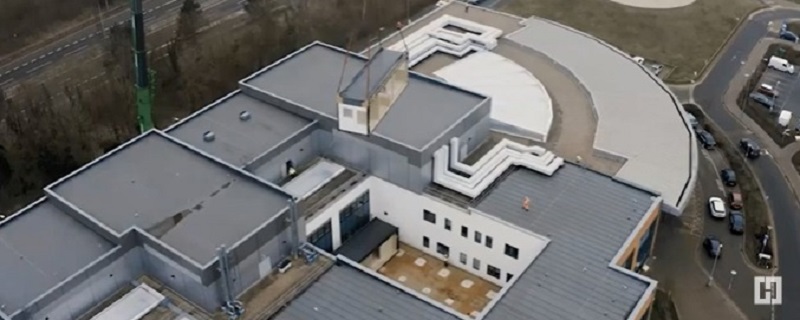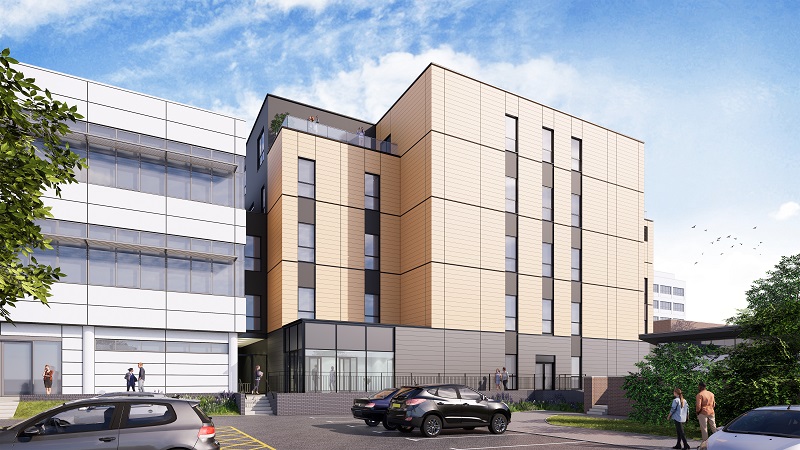The more-widespread adoption of modern methods of construction (MMC) could help to reduce the carbon impact of healthcare projects by up to 45%, according to new research.
An academic study by the University of Cambridge and Edinburgh Napier University looked at how carbon emissions could be reduced when using MMC for residential construction projects.
And it found that embodied carbon – the CO2 produced during the design, construction and decommissioning phases of a development – can be reduced by almost half (41-45%) utilising the offsite approach because buildings require lower volumes of carbon-intensive products such as concrete and steel.
While the research focused on two residential developments, it is expected that the efficiencies can be replicated across all sectors, including healthcare.
A report published by the researchers shows that emissions were lower than a traditional approach where all construction takes place onsite.
This is because indirect carbon emissions, such as those caused by deliveries and onsite workers, are reduced.
The patient has to come first, so we have to design the optimum space for patient experience, clinical outcomes, and operational efficiency, then find an MMC solution to help us create this
The study found that 28,000 tonnes of embodied carbon emissions were saved from construction across both schemes combined – the equivalent of the CO2 absorbed by 1.3 million trees in a year.
The two residential developments, made up of 879 homes, were delivered using a modular system by Tide Construction.
“Modular brings investors, occupiers, and their professional teams a great opportunity to significantly reduce whole-life carbon emissions, supporting their environmental, social, and governance plans and access to green finance,” said Christy Hayes, chief executive of Tide Construction.

Health Spaces delivered a staff welfare facility at Peterborough City Hospital, with all modules being craned onto the site over just three days, compared to the months it would have taken if using traditional construction methods
Dr Tim Forman, senior research associate at the University of Cambridge, added: “Buildings are responsible for approximately 40% of global energy-related carbon emissions and there is an urgent need to reduce the carbon intensity of construction and buildings in use.
“As buildings become more energy efficient in operation; reducing the carbon associated with construction, including the production and transportation of materials and site activities and their end of life, is becoming increasingly significant.
“This study underscores the fundamental importance of quantifying carbon in construction and across a building’s lifecycle.”
In a recent webinar, Justin Bass, consultant director at Health Spaces, said MMC would be crucial in meeting the Government’s commitment to a net-zero health service by 2040.
Citing minimal onsite disruption and faster delivery times as key drivers for more-widespread adoption of MMC within the health sector, he agreed that sustainability and carbon reduction were also making the approach more attractive to NHS organisations.
He said: “MMC isn’t just modular; it offers so much more.
“It is really exciting to see these new technologies and systems being developed and it really does deserve our attention.
“MMC delivers great buildings for longevity and aesthetics and the NHS’s net-zero promise is one of the big national drivers for this approach.
“We are already seeing a reduction in waste through the use of MMC and a lot of MMC technologies use recycled product and low-carbon products to reduce embodied carbon in buildings.
“We are also able to use all-electric systems for heating and improved thermal properties and these work really well.”
We are already seeing a reduction in waste through the use of MMC and a lot of MMC technologies use recycled product and low-carbon products to reduce embodied carbon in buildings
But he said there were still some barriers to MMC and called for greater innovation.
He said: “Often there are budget constraints as more-sustainable solutions tend to cost more.
“There is also an issue of availability of electrical infrastructure as the net-zero agenda is putting pressure on the electrical supply required for buildings.
“With healthcare, in particular, there are also HTM and HBN design standards and something that works well for domestic or commercial projects can’t always reach the high standards required for healthcare, particularly around acoustics and fire safety.
“It would be great to see more investment for innovation in technologies for healthcare specifically.”
And, while he embraced the idea of standardisation across the MMC industry, he added: “We must be on our guard against the tail wagging the dog.
“The patient has to come first, so we have to design the optimum space for patient experience, clinical outcomes, and operational efficiency, then find an MMC solution to help us create this.
“So often we see an architect create a beautiful design, but because of the speed with which it must be delivered it gets rehashed to fit a contractor’s standard module size, which doesn’t always work and meet those original design requirements.

MMC can provide buildings comparable to those delivered through traditional construction methods. This new £20m critical care unit at the John Radcliffe Hospital in Oxford was delivered by MTX and is five storeys high
“Can you have both benefits of speed and design? The answer, I would say, is ‘yes’, but we are not quite there yet.
“For this to really work, NHS England, or another central body, needs to approve designs and invest in developing the concept, then rolling it out. But conflict between allowing trusts to act autonomously makes repeatability difficult to make happen in practice.”
Speaking to BBH this week, David Hartley, managing director of MMC specialist, MTX, said: “Without doubt the COVID pandemic has brought MMC to the fore and is now the preferred solution for healthcare projects.
“The recent study shows how MMC can help to reduce carbon emissions as construction work takes place offsite and in a controlled factory environment.
“The opportunity for net zero is huge, with all individual disciplines having their own recycling systems and processes so we can maximise the amount of recycling in a controlled environment.
“Ultimately, we are able to deliver facilities in much-shorter timeframes as the foundations are constructed in parallel to the offsite element.The opportunity for net zero is huge, with all individual disciplines having their own recycling systems and processes so we can maximise the amount of recycling in a controlled environment
“MMC is particularly attractive to the health sector because we are able to deliver infrastructure very, very quickly to meet the strategies and requirements of the NHS, which are constantly changing and evolving based on patient demographics, the ageing popular, and the significant advancement in science and the way we treat patients. Because of this, MMC solutions are a perfect fit.”
And he said that MMC could now be used to deliver major projects, with capabilities of up to 50 storeys.
“With MMC, we are still using steel and concrete and plasterboard and ceiling systems in the same way we would with traditional buildings, but we are building them in a different way.
“There are some disadvantages, such as using MMC for a large atrium in a central core of a hospital, which might need a combination of MMC and traditional construction to achieve the ceiling heights, but in the main MMC is a win-win approach and there are very few things you can’t do.”





